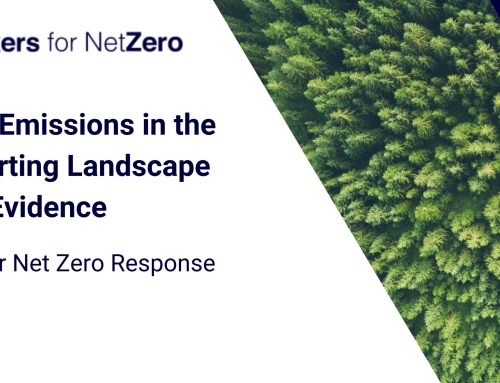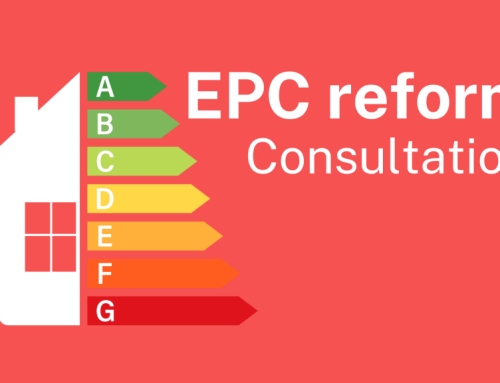Bankers for Net Zero Head of Policy and Public Affairs, Elena Pérez Celis recently responded to the GFANZ consultation on Transition Finance Strategies and Measuring the Impact on Emissions. You can read some of our responses below.
Are there any other considerations for Climate Solution attributes, especially relating to hurdles to implementation (e.g., additional KPIs to consider, data limitations, suggestions for specific attributes for Enablers)?
It is important to recognise the critical role of data in shaping effective climate solutions. There could be a KPI related to data assurance to ensure that the climate data is accurate and consistent. It could provide tangible metrics to evaluate the effectiveness of data-related processes in the context of climate solutions, addressing both the completeness and quality dimensions essential for informed decision-making and policy development. To assess this, it could be observed if companies are using determined verified and credible technologies which help minimise their GHG emissions.
Are there any other considerations for Aligned/Aligning attributes, especially relating to hurdles to implementation (e.g., data limitation, lack of disclosure regarding capex, other KPIs for degree of alignment)?
Assessing the sustainability practices within the entity’s supply chain. A commitment to net zero should extend beyond direct operations to include suppliers and partners.
A crucial aspect of evaluating an entity’s commitment to net-zero activities is the sustainability of its supply chain. Successful entities communicate sustainability requirements effectively and implement programs to assist suppliers in enhancing their own sustainability practices. The reduction of emissions throughout the supply chain is pivotal. Since SMEs are part of most companies’ supply chains, it is imperative that they provide them with the support they need to engage in decarbonisation efforts.
Transparency in the supply chain, disclosing relevant environmental and social performance data, is vital for risk management. There is a need for entities to be able to have accurate data for these purposes.
Collaborations on innovation and metrics indicating continuous improvement in sustainability contribute to a comprehensive evaluation of an entity’s commitment to net-zero activities and its efforts to drive positive environmental and social impact throughout the entire supply chain.
Are there any other considerations for Managed Phaseout attributes, especially relating to hurdles to implementation (e.g., data limitation, lack of disclosure regarding capex, other KPIs for tracking phaseout progress)?
One key aspect of Managed Phaseout involves a comprehensive understanding of an entity’s current assets and their associated environmental impact. Entities may face difficulties in creating a detailed inventory of their assets, especially if they lack standardized processes for monitoring and reporting.
Additionally, incomplete asset inventories may result in a partial view of an entity’s environmental footprint, hindering the development of targeted phaseout strategies and affecting the accuracy of categorization within Managed Phaseout.
Considering the proposed approaches, do you foresee any potential unintended consequences that may disincentivize financing in the four key financing strategies or motivate behaviour that may not be supportive of the net-zero transition?
The segmentation method’s reliance on categorization into groups like Climate Solutions, Aligned, Aligning, and Managed Phaseout could introduce challenges as entities evolve and strategies change, potentially hindering the flexibility required for an effective net-zero transition.
Additionally, the method’s binary distinction between fully aligned and non-aligned entities might exclude those making genuine efforts toward sustainability but falling short of strict criteria, discouraging engagement in the net-zero transition.
Finally, if the segmentation structure focuses on short-term metrics for immediate categorization benefits, this may lead to financing strategies prioritizing quick wins rather than addressing the deeper changes necessary for sustained impact. To mitigate these potential consequences, GFANZ should prioritize continuous review, adaptability, stakeholder feedback, and transparency in reporting, ensuring the segmentation method remains a dynamic tool in incentivizing financing strategies aligned with the net-zero transition. Regular evaluations and adjustments will be crucial to maintaining the method’s integrity and relevance over time.
If you were to implement the proposed approaches today, what could be some challenges you might encounter?
The implementation of the proposed approaches of the GFANZ segmentation method introduces several challenges, particularly when focusing on data considerations. One significant hurdle is ensuring the accuracy of the data required for categorization. Many entities, especially SMEs, may lack sophisticated monitoring systems or standardized processes for collecting comprehensive sustainability data. This poses a risk of inaccurate or incomplete data, compromising the reliability of the segmentation method and hindering its ability to accurately reflect entities’ net-zero alignment.
Another complex challenge lies in establishing standardized reporting metrics applicable across diverse industries and regions. The lack of global binding frameworks may result in inconsistent interpretations of alignment, making it challenging for entities to assess and report their net-zero progress accurately. Some entities, especially SMEs, may lack the resources and expertise needed for robust data collection and reporting, potentially distorting the overall assessment of net-zero alignment.
Delays in reporting, influenced by varying financial cycles and reporting capabilities, could impact the timeliness of updates, diminishing the segmentation method’s effectiveness.
Furthermore, there’s a risk of greenwashing, where entities strategically present activities to appear more aligned than they genuinely are, potentially eroding trust in the reliability of the segmentation method.
What is your organization’s preferred approach for measuring the impact of transition finance activities, for example for capital allocation, monitoring, and disclosure purposes? What are the benefits and drawbacks of these approaches?
Banks need to engage with automated data sets to obtain primary data from SMEs. There are already initiatives like this such as the Perseus programme. Perseus is run by Bankers for NetZero and Icebreaker One and aims to develop whole-of-market solutions to create rapidly scalable, low-effort, low-friction sustainability reporting. It seeks to unlock access to capital by automating GHG reporting for every small and medium enterprise (SME) in the UK.
Perseus aims to fill in the gap of not having a standard for SME sustainability reporting with an operational pilot by COP28. In December, Bankers for Net Zero announced a strategic partnership with the OECD on Perseus and there is intense interest in how the initiative can scale globally. Perseus has been recognized in the UK Government’s Green Finance Strategy as the pathway to lead the UK towards its decarbonization efforts.
SMEs have two important things in common: A bank and an energy supply. Taking that as a common point, and building on the principles of open banking, Perseus will allow data to flow from source (energy companies) to the financial economy (banks) with the permission of the customer (SMEs). The success of Open Banking proves it is possible to create scalable data-sharing infrastructure with financial-grade security.
Carbon calculators are currently built on proxy data / estimations / spend based analysis which is hampering investment decision making. Perseus moves away from this to facilitate verifiable, primary data share, from source, to flow to the financial economy.
Despite over 5.9 million SMEs in the UK (employing 16.8 million and delivering £2.3 trillion to the economy), there is not yet a dominant standard for SMEs to report GHG emissions. Moreover, measuring emissions across their operations and value chain can be a challenging task for SMEs, who often lack the necessary resources and expertise. As a result, emission data is disjointed. ESG related data is not flowing between banks/asset managers and their customers/clients which have also implications for greenwashing. By improving transparency, accountability and consistency across the sector, data assurance can improve both trust in, and the trustworthiness of, environmental performance data and help ensure the green finance agenda to succeed. The only way to tackle green washing is to have the right mechanisms to access primary data from source. Engaging in Perseus is a solution to this problem and contributes to measuring the impact of transition finance for disclosure purposes.
What are key considerations for the development of a decarbonization contribution methodology? What challenges do you anticipate?
In the development of a decarbonization contribution methodology, a key consideration is the prioritization of transparency in reporting. This transparency is crucial for building trust and accountability, as it ensures that stakeholders, be they investors, customers, or the broader public, can grasp the intricacies of the organization’s decarbonization journey.
However, one of the main challenges is obtaining accurate and comprehensive data on current emissions and relevant factors. Corporate ESG data is not sufficiently available on the market, especially for SMEs. Banks should take the initiative and start to consolidate their clients’ sustainability data. Currently, ESG related data is not flowing between banks/asset managers and their customers/clients. This hampers effective decisions and investments needed to accelerate net zero. We need to develop functioning data ecosystems using open standards to allow this data to flow. There are often limited frameworks or guidance about what data is needed. These are often emerging topics that society is trying to tackle through ESG disclosure, but which are not yet captured by available reporting frameworks. These include issues associated with supply chain reporting. There are still pending challenges in formulating indicators and standardising reporting. Emerging climate policies and regulations present a challenge. Organizations may face uncertainty about future regulatory requirements, making it challenging to align decarbonization strategies with evolving standards. There are currently various policy frameworks which bring policy uncertainty given there is not a clear direction on travel as there is currently not best practice.

